Doji Candle

Όταν οι έμποροι αναλύουν την αγορά, βασίζονται σε μοτίβα που σχηματίζονται στα διαγράμματα τιμών, με τα κεριά Doji να αποτελούν ένα από τα πιο ευρέως χρησιμοποιούμενα εργαλεία. Αντικατοπτρίζοντας τις ενδοημερήσιες και μεσοπρόθεσμες αλλαγές τιμών, τα κεριά Doji υποδηλώνουν αβεβαιότητα στην αγορά ή μια πιθανή επερχόμενη αλλαγή στην υπάρχουσα τάση.
Το παρόν άρθρο ασχολείται με τα Ιαπωνικά κεριά και την ανάλυση γραφημάτων. Εξηγεί πώς σχηματίζονται τα κεριά Doji, πώς να τα ερμηνεύετε και να διαμορφώνετε στρατηγικές, ενώ περιλαμβάνει παραδείγματα διαφόρων τύπων Doji.
Περιεχόμενα
Τι είναι το κερί Doji;
Πώς σχηματίζεται το ιαπωνικό κερί Doji;
Πώς λειτουργεί;
Παράδειγμα μοτίβου κεριού doji στην αγορά Forex
Τύποι κεριών doji
Πλεονεκτήματα και Μειονεκτήματα του Κεριού Doji
Τι διαφορά υπάρχει μεταξύ ενός doji και ενός spinning top;
Πώς να διαβάσετε ένα κερί Doji
Πώς να Χρησιμοποιήσετε το Κερί Doji στο Trading – Καλύτερη Στρατηγική
Συναλλαγές με ένα standard doji
Συναλλαγές με Dragonfly Doji
Συναλλαγές με ένα Doji Star
Συμπέρασμα
Συχνές Ερωτήσεις (FAQ)
Τι είναι το κερί Doji;
Ένα Ιαπωνικό κερί Doji είναι ένας σχηματισμός κεριού που εμφανίζεται στα διαγράμματα όταν η αγορά βρίσκεται σε κατάσταση αβεβαιότητας και δεν παρατηρείται σημαντική κίνηση τιμών. Συχνά, το Doji υποδηλώνει τη δυνατότητα αντιστροφής της τάσης, λειτουργώντας ως ένδειξη για πιθανές αλλαγές στην κατεύθυνση της αγοράς.
Πώς σχηματίζεται το ιαπωνικό κερί Doji;
Το μοτίβο doji μπορεί να υποδεικνύει το σχηματισμό μιας κορυφής και είναι αρκετά συνηθισμένο στο εμπόριο, ιδιαίτερα όταν εμφανίζεται μετά από ένα μακρύ λευκό (ευνοϊκό) κερί. Ένα doji προειδοποιεί τους αγοραστές για την εξασθένιση της ζήτησης και για μια πιθανή αρνητική αντιστροφή, ειδικά όταν μια θετική τάση έχει διαρκέσει για κάποιο χρονικό διάστημα και το περιουσιακό στοιχείο είναι υπερτιμημένο.
Ωστόσο, το σήμα του doji μειώνεται σε ισχύ όταν η αγορά είναι σε πτώση. Το κερί doji αναγγέλλει την ύπαρξη ίσων δυνάμεων στην αγορά, πράγμα που σημαίνει ότι είναι πιθανή τόσο η ανάπτυξη όσο και η μείωση, και η πτωτική τάση μπορεί να συνεχιστεί.
Για να επιβεβαιώσουμε μια αναστροφή τιμής και την αρχή μιας νέας τάσης, είναι απαραίτητο να εντοπίσουμε ένα ισχυρότερο σήμα, ιδιαίτερα όταν η τάση έχει φτάσει σε χαμηλό επίπεδο. Για παράδειγμα, ένα τέτοιο σήμα μπορεί να είναι το μοτίβο doji "morning star", το οποίο σχηματίζεται από τρία κεριά.
Πώς λειτουργεί;
Τα κεριά doji αποτελούν πιθανό δείκτη επικείμενων αλλαγών στην αγορά και παραδοσιακά βοηθούν τους εμπόρους να εντοπίζουν κατώτερα και ανώτερα σημεία στις τιμές.
Για παράδειγμα, ένα κερί doji που εμφανίζεται κατά τη διάρκεια μιας ανόδου μπορεί να σηματοδοτεί εξάντληση της ανόδου, καθώς οι αγοραστές αρχίζουν να μειώνουν τη δραστηριότητά τους και οι πωλητές αποκτούν μεγαλύτερη παρουσία, προκαλώντας πιθανή αντιστροφή της τάσης.
Ωστόσο, είναι σημαντικό να σημειωθεί ότι τα μοτίβα doji δεν υποδεικνύουν πάντα μια αναστροφή τάσης. Αντίθετα, αντικατοπτρίζουν την αβεβαιότητα των εμπόρων για την πορεία της αγοράς.
Για το λόγο αυτό, είναι προτιμότερο να χρησιμοποιούνται πρόσθετοι τεχνικοί δείκτες για να επιβεβαιώνονται τα σήματα από τα μοτίβα doji. Εργαλεία όπως ο Δείκτης Σχετικής Ισχύος (RSI) ή οι Bollinger Bands μπορούν να βοηθήσουν στην επιβεβαίωση ή την αμφισβήτηση των ενδείξεων που παρέχει ένα μοτίβο doji.
Παράδειγμα μοτίβου κεριού doji στην αγορά Forex
Μετά από μια σημαντική αύξηση με υψηλό όγκο, οι μετοχές της Cyanotech Corp. (CYAN) σχημάτισαν ένα κερί gravestone doji στο διάγραμμα τον Φεβρουάριο του 2018. Αυτό το μοτίβο μπορεί να αποτελεί προειδοποίηση για μια βραχυπρόθεσμη πτωτική αναστροφή μετά από τη διάσπαση.
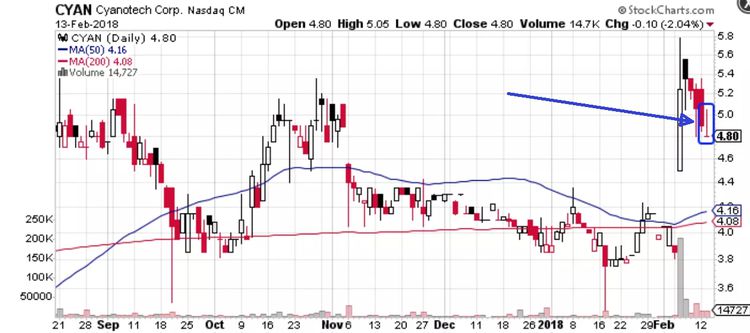
Σε αυτή την περίπτωση, το gravestone doji μπορεί να υποδηλώνει περαιτέρω πτωτική τάση από τα τρέχοντα επίπεδα, με στόχο να καλύψει το κενό στις κινούμενες μέσες των 50 ή 200 ημερών, οι οποίες βρίσκονταν στα $4.16 και $4.08 αντίστοιχα.
Για να επιβεβαιώσουν μια πιθανή πτώση, οι έμποροι συχνά εξετάζουν και άλλους τεχνικούς δείκτες, όπως ο Δείκτης Σχετικής Ισχύος (RSI) ή η Σύγκλιση/Απόκλιση Κινούμενων Μέσων (MACD). Οι μεσοπρόθεσμοι έμποροι, σε αυτή την περίπτωση, μπορεί να επιλέξουν ένα μεγαλύτερο stop-loss για να αποφύγουν την πρόωρη έξοδο από τη θέση τους, ενώ οι ημερήσιοι έμποροι πιθανότατα θα θέσουν ένα stop-loss σε υψηλότερο επίπεδο, περίπου στα $5.10.
Τύποι κεριών doji
Ανάλογα με το μήκος και τη δύναμη της τάσης στην αγορά, τα κεριά doji χωρίζονται σε διάφορους τύπους. Ας τους δούμε πιο αναλυτικά:
Standard doji
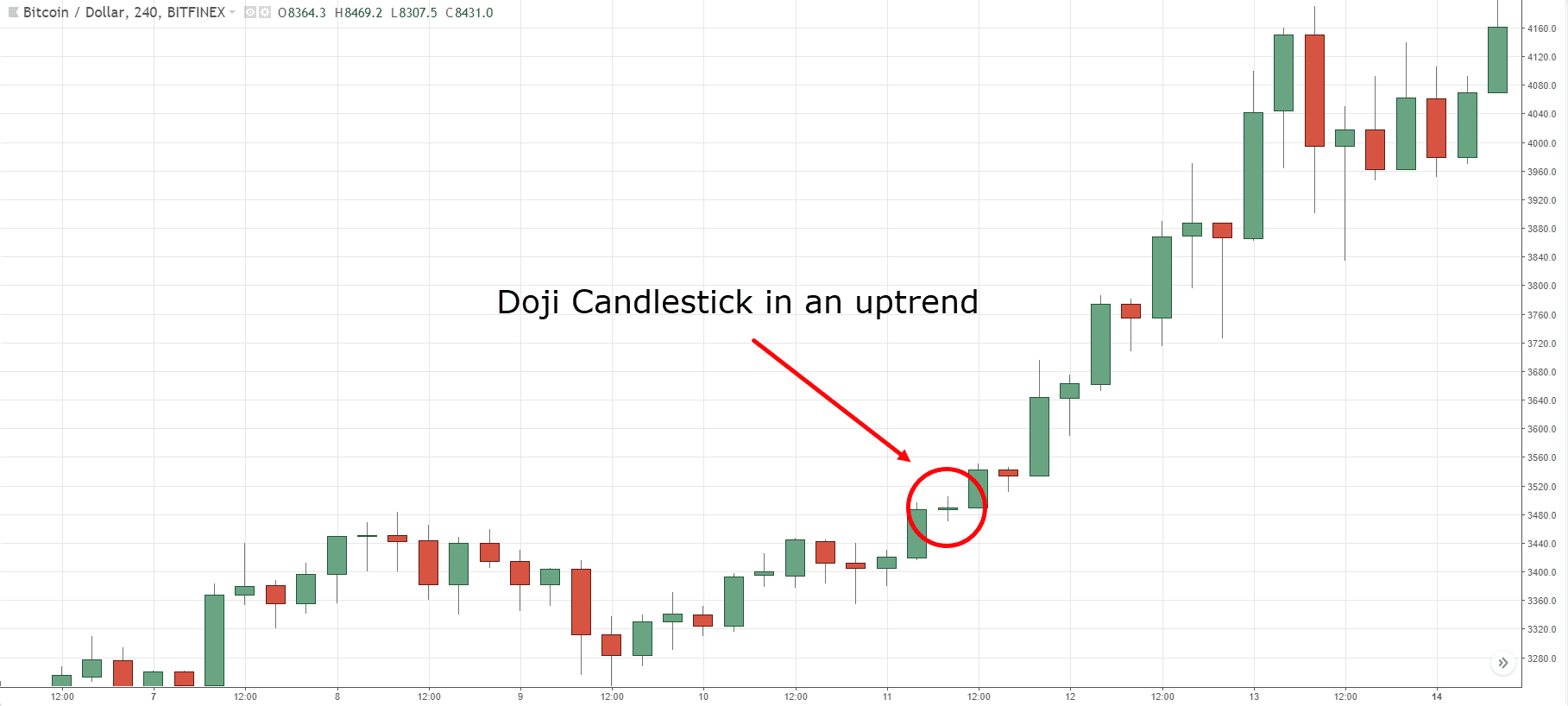
Το standard doji είναι ένα μεμονωμένο κερί που από μόνο του δεν υποδηλώνει απαραίτητα κάτι σημαντικό. Οι έμποροι εξετάζουν τη δραστηριότητα της τιμής που οδήγησε στο doji για να καθορίσουν την ερμηνεία του.
Τα μοτίβα κεριών doji πρέπει να θεωρούνται ως αρχικό σημείο ανάλυσης για τις συναλλαγές. Για παράδειγμα, ένα standard doji που εμφανίζεται μέσα σε μια ανοδική τάση μπορεί να αποτελεί μέρος της συνέχισης της τάσης αυτής. Ωστόσο, σε κάποιες περιπτώσεις, όπως φαίνεται στο παρακάτω διάγραμμα, μπορεί να σηματοδοτεί την αναστροφή της ανοδικής τάσης, αναδεικνύοντας τη σημασία της επιβεβαίωσης.
Αυτό υπογραμμίζει ότι το standard doji δεν αποτελεί αξιόπιστο σήμα από μόνο του. Είναι απαραίτητο οι έμποροι να περιμένουν επιβεβαίωση από άλλους τεχνικούς δείκτες ή πρόσθετα σήματα από το διάγραμμα πριν λάβουν αποφάσεις για δράση.
Dragonfly doji
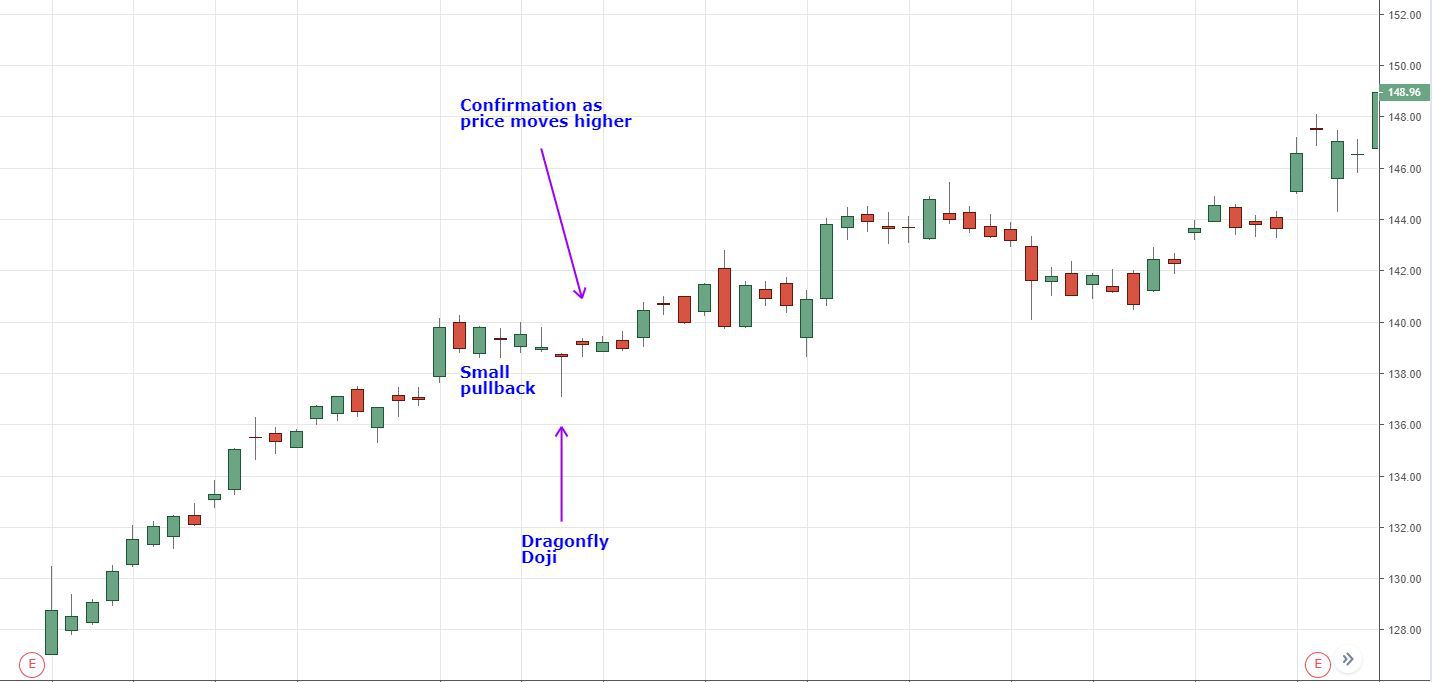
Το dragonfly doji έχει σχήμα "Τ" και θυμίζει δράκο. Συνήθως σχηματίζεται σε μια καθοδική κίνηση και υποδηλώνει πιθανή αναστροφή της τάσης, αν και μπορεί να εμφανιστεί και κατά τη διάρκεια μιας ανόδου. Σε αυτή την περίπτωση, απαιτείται περαιτέρω επιβεβαίωση από άλλα μοτίβα κεριών για να θεωρηθεί αξιόπιστο.
Το dragonfly doji χαρακτηρίζεται από μεγαλύτερη σκιά προς τα κάτω και ελάχιστη ή καθόλου σκιά προς τα πάνω, γεγονός που του προσδίδει πιο ανοδική (bullish) διάσταση. Αυτό το μοτίβο υποδηλώνει ότι οι αγοραστές απέκτησαν τον έλεγχο της αγοράς κατά τη διάρκεια της περιόδου, αφού η τιμή σημείωσε σημαντική πτώση αλλά τελικά ανέκαμψε και έκλεισε κοντά στην αρχική τιμή. Αυτό φανερώνει πιθανή ισχυρή στήριξη και πιθανότητα αντιστροφής μιας πτωτικής τάσης.
Όπως και με όλα τα μοτίβα doji, η αξιοπιστία του σήματος εξαρτάται από την επιβεβαίωση μέσω άλλων τεχνικών δεικτών ή από τη συμπεριφορά των επόμενων κεριών στο διάγραμμα.
Long-legged doji
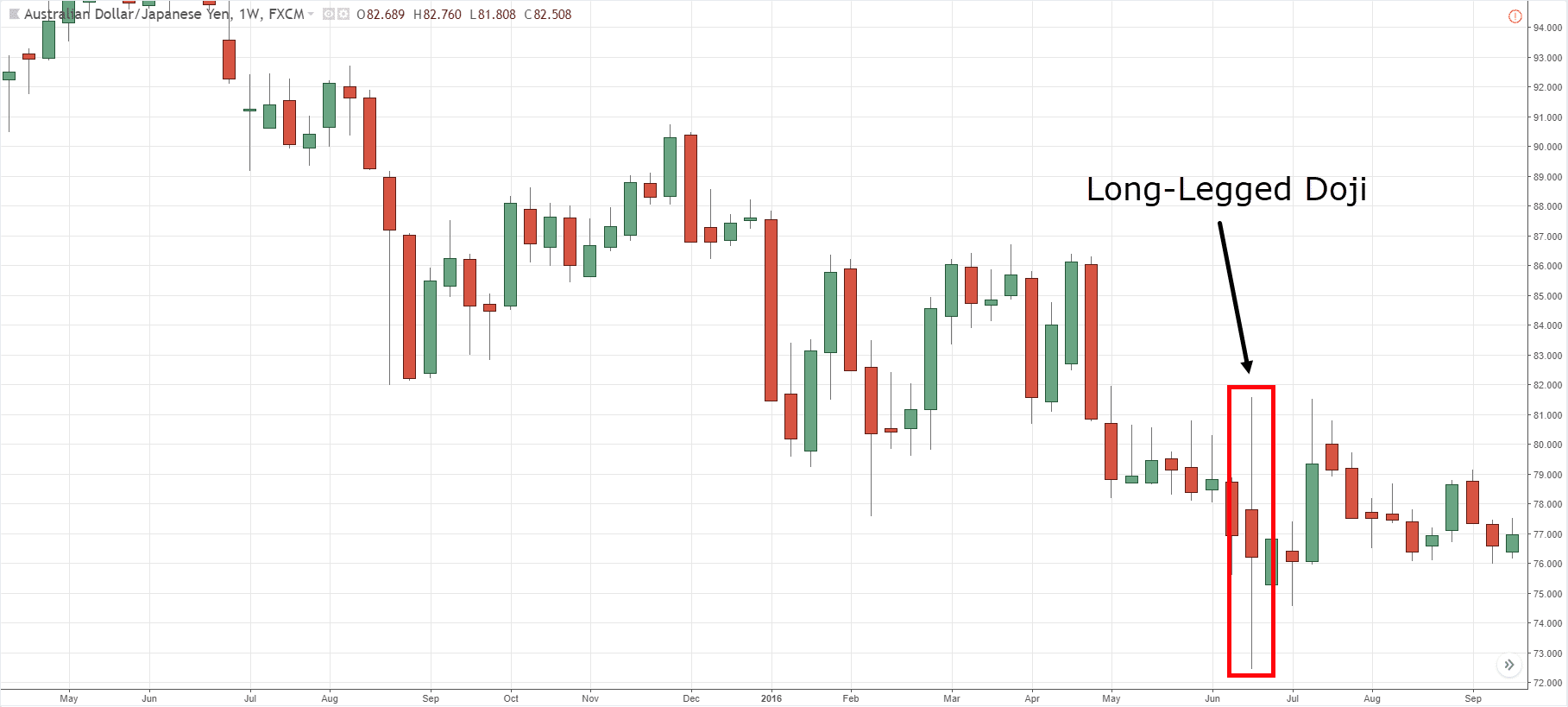
Το long-legged doji χαρακτηρίζεται από εκτεταμένες σκιές τόσο προς τα πάνω όσο και προς τα κάτω, υποδεικνύοντας σημαντική αβεβαιότητα στην αγορά. Αυτό το μοτίβο είναι συνηθισμένο στην κορυφή μιας τάσης και συχνά δίνει πλεονέκτημα στους πτωτικούς εμπόρους (bearish traders), καθώς η αβεβαιότητα μπορεί να οδηγήσει σε αντιστροφή της τάσης.
Κατά τη διάρκεια της περιόδου, η τιμή παρουσιάζει μεγάλη άνοδο στην αρχή, ακολουθούμενη από πτώση, και στο τέλος επιστρέφει κοντά στο επίπεδο ανοίγματος ή λίγο πιο πάνω.
<>Όταν η τιμή βρίσκεται στο μέσο της συνολικής διακύμανσης και οι σκιές έχουν ακριβώς το ίδιο μήκος, το κερί αναφέρεται ως rickshaw.
Υπάρχει επίσης ένας άλλος τύπος doji, γνωστός ως high wave doji, το οποίο έχει μικρό σώμα και μία ή δύο πολύ μακρές σκιές. Το high wave doji αντικατοπτρίζει έντονη αβεβαιότητα στην αγορά, με την τιμή να σημειώνει μεγάλες διακυμάνσεις και να επιστρέφει σε υψηλά επίπεδα, φανερώνοντας την αναποφασιστικότητα των εμπόρων.
Gravestone doji
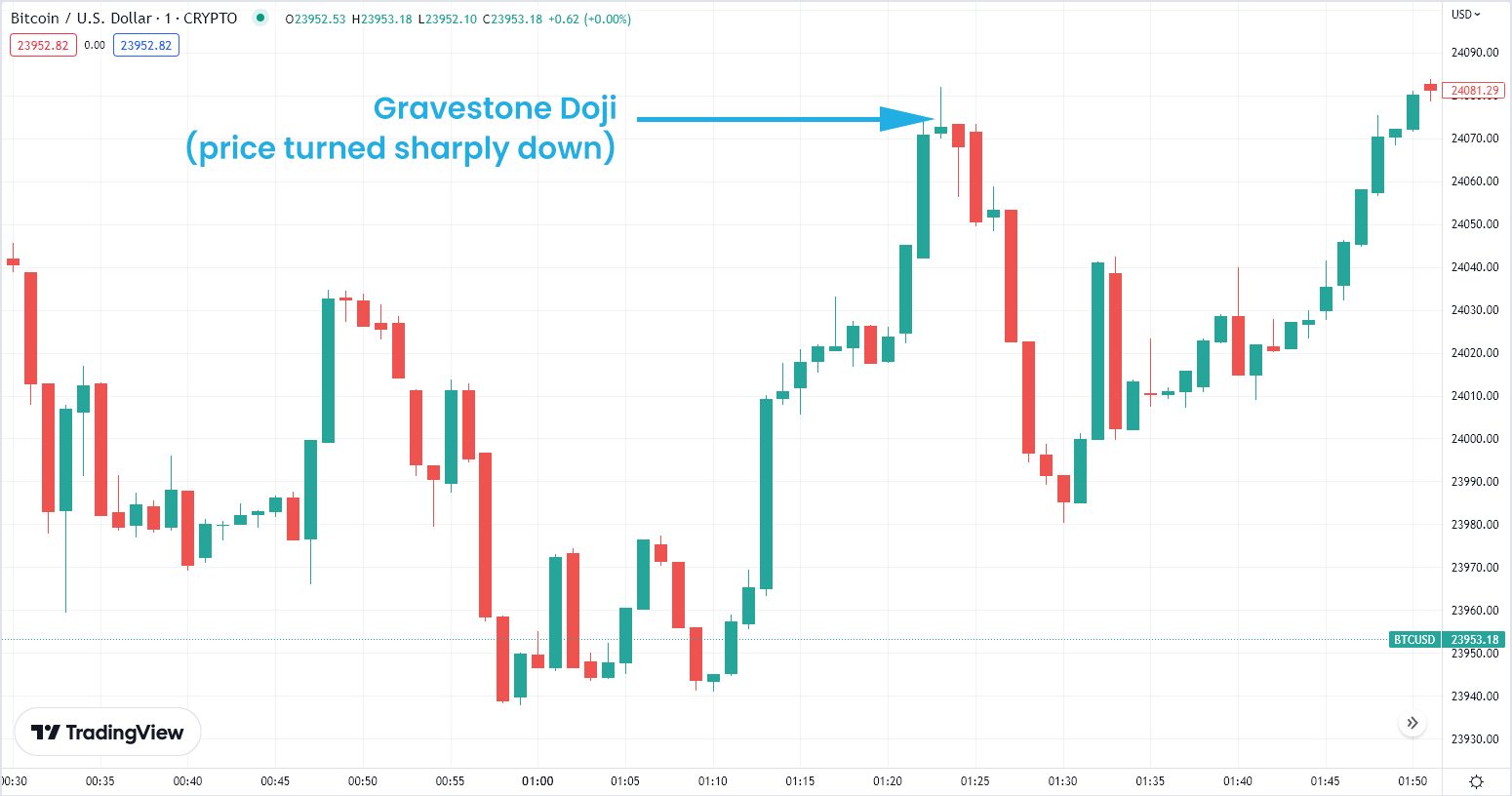
Το gravestone doji αποτελεί προειδοποιητικό σημάδι ότι η τρέχουσα τάση φτάνει στα όριά της και είναι πιθανό να αλλάξει κατεύθυνση.
Σχηματίζεται όταν οι τιμές ανοίγματος, χαμηλής και κλεισίματος βρίσκονται κοντά μεταξύ τους, ενώ υπάρχει μια μακριά άνω σκιά. Αυτό το μοτίβο θεωρείται ένδειξη αντιστροφής προς τα κάτω (bearish reversal candlestick pattern).
Οι ανοδικοί έμποροι (bullish traders) θα πρέπει να είναι έτοιμοι να κλείσουν τις θέσεις τους, καθώς το gravestone doji είναι ένα ισχυρό σήμα σε μια ανοδική τάση που προειδοποιεί για ενδεχόμενη δραστηριότητα πτώσης (bearish activity) στα παρόντα επίπεδα.
Αντίστοιχα, ένα dragonfly doji μπορεί να εμφανιστεί στην κορυφή μιας καθοδικής τάσης, αλλά σε αυτή την περίπτωση απαιτείται περαιτέρω επιβεβαίωση για την εγκυρότητα του σήματος.
Η ισχύς του σήματος αντιστροφής του gravestone doji αυξάνεται με το μήκος της άνω σκιάς. Όσο μεγαλύτερη είναι η άνω σκιά, τόσο πιο ισχυρό είναι το σήμα για επικείμενη πτώση στην αγορά.
Four-price doji
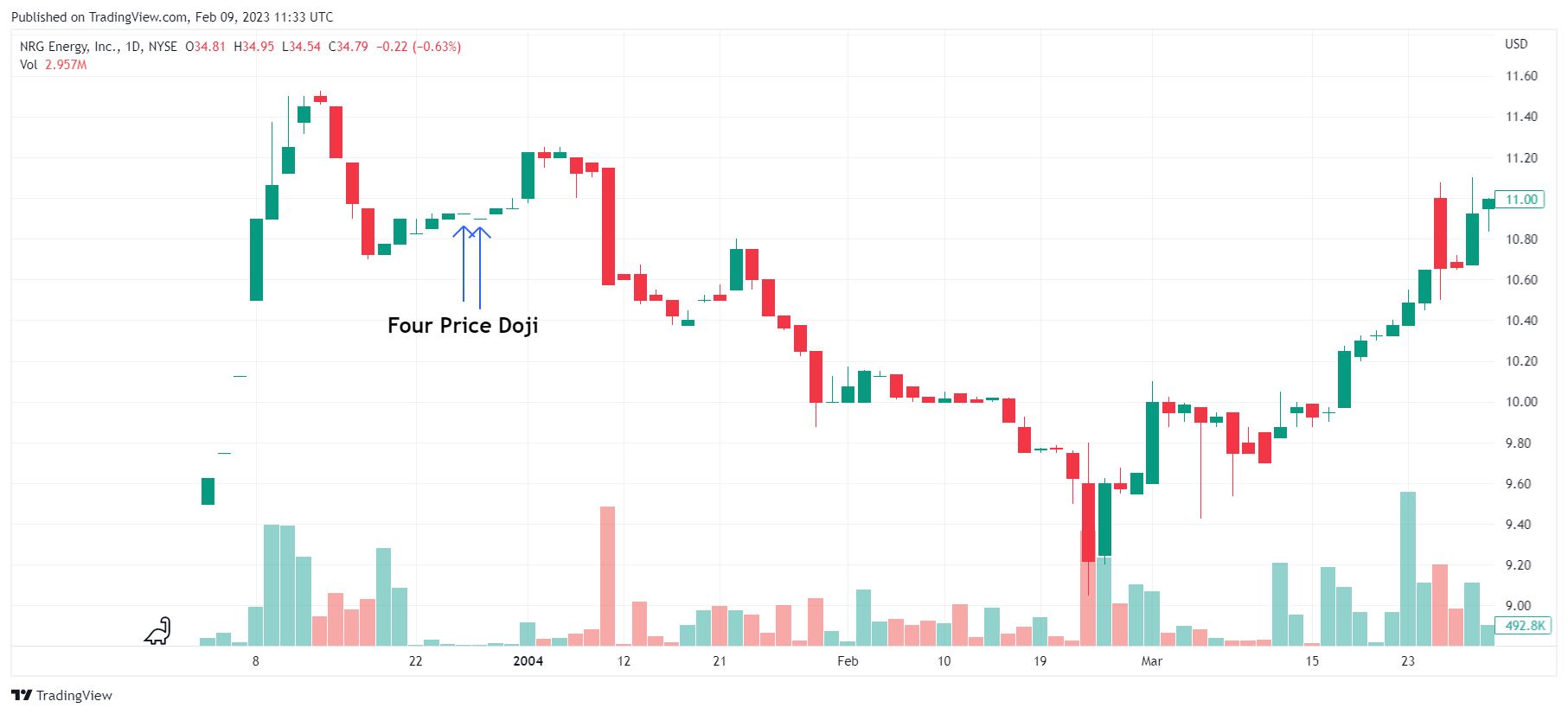
Το four-price doji εμφανίζεται ως μια απλή οριζόντια γραμμή, χωρίς κάθετες γραμμές πάνω ή κάτω από αυτήν. Αυτό συμβαίνει επειδή όλες οι τιμές του κεριού (άνοιγμα, κλείσιμο, υψηλότερη και χαμηλότερη τιμή) είναι ίδιες. Το συγκεκριμένο μοτίβο υποδηλώνει απόλυτη αβεβαιότητα των εμπόρων.
Το four-price doji είναι χαρακτηριστικό μοτίβο που δείχνει αμφιβολία ή μια πολύ ήσυχη αγορά. Συνήθως σχηματίζεται όταν οι αγοραστές και οι πωλητές βρίσκονται σε απόλυτη ισορροπία, χωρίς να επικρατεί καμία πλευρά.
Αυτό το μοτίβο συχνά σηματοδοτεί περίοδο αναμονής ή αβεβαιότητας, κατά την οποία δεν υπάρχει ξεκάθαρη κατεύθυνση για την αγορά.
Πλεονεκτήματα και Μειονεκτήματα του Κεριού Doji
| Πλεονεκτήματα |
Μειονεκτήματα |
| Στην κορυφή της τάσης, παρέχει ισχυρές ενδείξεις αντιστροφής. |
Μπορεί να υποδείξει λανθασμένες κινήσεις προς αντίθετες κατευθύνσεις, δημιουργώντας παγίδες για αγοραστές και πωλητές. |
| Δείχνει διακυμάνσεις στην αγορά, οι οποίες μπορούν να αξιοποιηθούν για κερδοφόρες συναλλαγές. |
Ένα doji σε καθοδική τάση ενδέχεται να υποδεικνύει συνέχιση της τάσης αντί για αντιστροφή, μπερδεύοντας τους εμπόρους. |
| Μεγιστοποιεί το κέρδος από μια μεμονωμένη συναλλαγή, ειδικά όταν χρησιμοποιείται σε χρονικά πλαίσια μίας ώρας ή περισσότερο. |
Εξαιτίας της υψηλής ευαισθησίας του στο θόρυβο της αγοράς, δεν είναι αποτελεσματικό σε μικρότερα χρονικά πλαίσια. |
Τι διαφορά υπάρχει μεταξύ ενός doji και ενός spinning top;
Τα διαγράμματα με κεριά (candlestick charts) επιτρέπουν την ανάλυση μοτίβων της αγοράς, βοηθώντας στην κατανόηση των συναισθημάτων των εμπόρων, της δυναμικής και της αστάθειας. Τα μοτίβα των κεριών λειτουργούν ως δείκτες αυτών των δραστηριοτήτων και αντιδράσεων της αγοράς.
Υπάρχουν διαφορές στον τρόπο με τον οποίο οι τεχνικοί αναλυτές ερμηνεύουν τα μοτίβα, αλλά τόσο τα doji όσο και τα spinning tops δείχνουν ότι οι δυνάμεις αγοράς και πώλησης είναι ουσιαστικά ισορροπημένες.
Τα doji και τα spinning tops μοιάζουν αρκετά, με τη βασική διαφορά ότι τα spinning tops έχουν μεγαλύτερα σώματα και πιο κοντές σκιές (ή "wicks"). Για να χαρακτηριστεί ένα κερί ως doji, το σώμα του πρέπει να καταλαμβάνει λιγότερο από το 5% της συνολικής διάστασης του κεριού. Αν το σώμα είναι μεγαλύτερο, τότε θεωρείται spinning top.
Πώς να διαβάσετε ένα κερί Doji
Η ερμηνεία των κεριών doji σε διαγράμματα candlestick περιλαμβάνει την ανάλυση των τιμών ανοίγματος, υψηλού, χαμηλού και κλεισίματος για την κατανόηση πιθανών αναστροφών ή αβεβαιότητας στην αγορά. Ακολουθεί ένας οδηγός βήμα προς βήμα:
- Εξετάστε τη δομή ενός κεριού Doji
Ένα doji σχηματίζεται όταν οι τιμές ανοίγματος και κλεισίματος είναι σχεδόν ίδιες ή ταυτόσημες, δημιουργώντας ένα μικρό ή ανύπαρκτο πραγματικό σώμα. Στο διάγραμμα, εμφανίζεται ως σταυρός ή σύμβολο +.
- Προσδιορίστε την τάση
Καθορίστε αν η γενική τάση της αγοράς είναι ανοδική (bullish) ή καθοδική (bearish). Το πλαίσιο αυτό είναι απαραίτητο για την αξιολόγηση της σημασίας του doji.
- Ελέγξτε τις σκιές
Παρατηρήστε το μήκος των ανώτερων και κατώτερων σκιών (γνωστές και ως "wicks"). Μακρύτερες σκιές υποδηλώνουν μεγαλύτερη αστάθεια, ενώ κοντύτερες δείχνουν περιορισμένη κίνηση των τιμών.
- Λάβετε υπόψη το μέγεθος του κεριού Doji
Ένα μικρό doji που εμφανίζεται μετά από μια έντονη κίνηση τιμών μπορεί να υποδεικνύει πιθανή αναστροφή τάσης ή φάση ενοποίησης.
- Ερμηνεύστε τα μοτίβα
Αναγνωρίστε τον τύπο του doji. Για παράδειγμα:
- Το gravestone doji (μακρά ανώτερη σκιά, χωρίς κατώτερη) υποδηλώνει πιθανή καθοδική αναστροφή.
- Το dragonfly doji (μακρά κατώτερη σκιά, χωρίς ανώτερη) υποδεικνύει πιθανή ανοδική αναστροφή. - Αναζητήστε επιβεβαιωτικά σήματα
Μην στηρίζεστε αποκλειστικά στο doji. Χρησιμοποιήστε πρόσθετους τεχνικούς δείκτες (όπως RSI ή Bollinger Bands), μοτίβα διαγραμμάτων ή γραμμές τάσης για να επιβεβαιώσετε την ανάλυσή σας.
- Προχωρήστε σε ενέργειες βάσει της ανάλυσής σας
Ανάλογα με τις συνθήκες της αγοράς και τα επιβεβαιωτικά σήματα, αποφασίστε αν πρέπει να αγοράσετε, να πουλήσετε ή να περιμένετε περαιτέρω επιβεβαίωση πριν προχωρήσετε.
Πώς να Χρησιμοποιήσετε το Κερί Doji στο Trading – Καλύτερη Στρατηγική
Τώρα που έχετε κατανοήσει πώς μοιάζουν τα κεριά doji και πώς να τα ερμηνεύετε, ας προχωρήσουμε στο πρακτικό μέρος: τη δημιουργία στρατηγικών συναλλαγών. Παρακάτω ακολουθούν δύο παραδείγματα που δείχνουν πώς να χρησιμοποιήσετε τα doji στη στρατηγική σας, ένα για το standard doji και ένα για το dragonfly doji.
Συναλλαγές με ένα standard doji

Όπως μπορείτε να δείτε, το μοτίβο του κεριού doji εμφανίστηκε μετά από μια μικρή διόρθωση κατά τη διάρκεια μιας ανοδικής τάσης που μόλις είχε ξεκινήσει. Το ερώτημα είναι: θα διατηρηθεί η τιμή στην ανοδική τάση ή θα αρχίσει να κινείται πτωτικά;
Για να αποκτήσουμε μια πιο ακριβή εικόνα, εξετάσαμε τον στοχαστικό δείκτη (stochastic). Δεδομένου ότι η τιμή δεν πλησιάζει το επίπεδο των υπεραγορασμένων, αυτό υποδεικνύει ότι υπάρχει ακόμα περιθώριο για περαιτέρω ανάπτυξη.
Πάντα να ελέγχετε τον στοχαστικό δείκτη ή τον δείκτη RSI για να αποκτήσετε ένα πιο σαφές σήμα, ειδικά όταν το μοτίβο doji εμφανίζεται κοντά σε επίπεδα αντίστασης σε μια ανοδική τάση ή σε επίπεδα στήριξης σε μια καθοδική τάση.
Η καλύτερη στρατηγική είναι να περιμένετε την εμφάνιση του επόμενου κεριού. Αν αυτό σπάσει πάνω από το υψηλό ή κάτω από το χαμηλό του doji, αυτό μπορεί να χρησιμοποιηθεί ως σημείο εισόδου για τις συναλλαγές σας.
Συναλλαγές με Dragonfly Doji
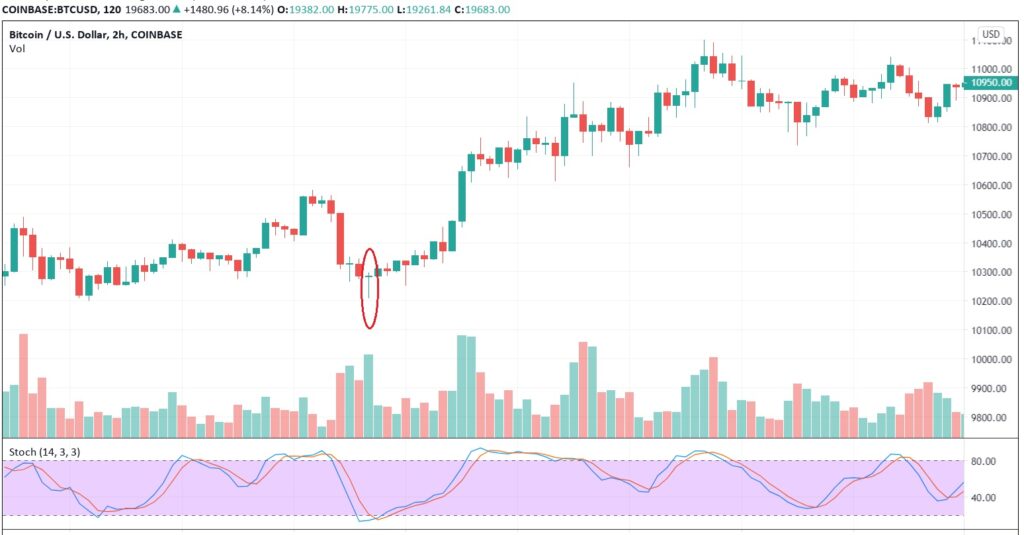
Μετά από μια απότομη πτωτική κίνηση, σχηματίστηκε το Dragonfly Doji. Αυτό το συγκεκριμένο μοτίβο doji προμηνύει συνήθως μια αναστροφή της τάσης, κάτι που επιβεβαιώθηκε και στην περίπτωσή μας.
Επιπλέον, μετά το πτωτικό κερί, ο στοχαστικός δείκτης πλησίασε το επίπεδο υπερπουλημένου, υποδεικνύοντας ότι το Dragonfly Doji είχε ιδιαίτερη σημασία. Μετά την εμφάνισή του, η τιμή άρχισε να ανεβαίνει αργά και, στη συνέχεια, η ταχύτητα της ανόδου αυξήθηκε σημαντικά.
Αντίστοιχα, το γράφημα μπορεί να σχηματίσει το μοτίβο Gravestone Doji όταν η τιμή αυξάνεται για μια παρατεταμένη περίοδο. Αυτό το μοτίβο είναι ουσιαστικά ένα αναστραμμένο Dragonfly Doji και εμφανίζεται πριν από την αναστροφή μιας ανοδικής τάσης, προειδοποιώντας για πιθανή πτώση.
Συναλλαγές με ένα Doji Star
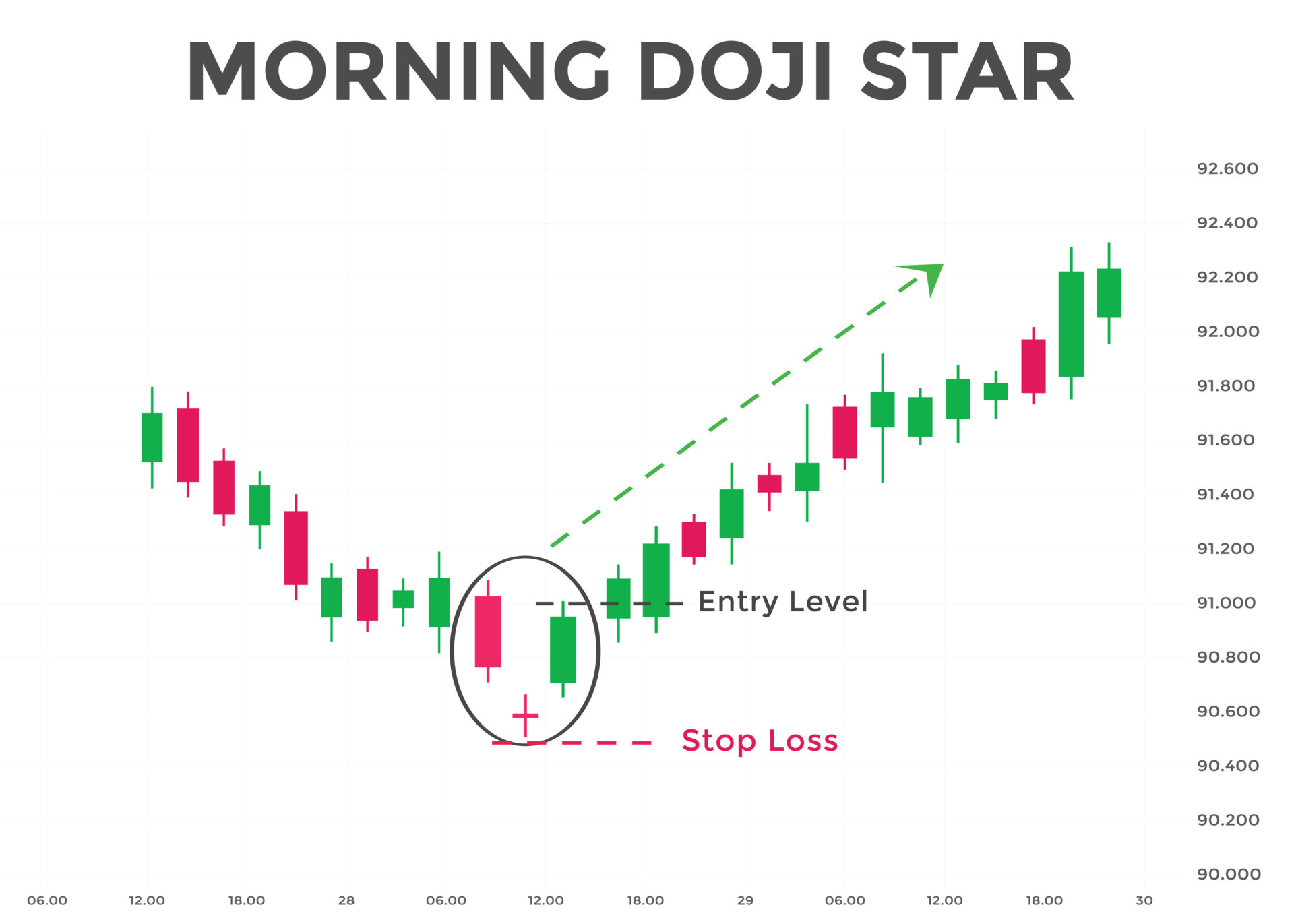
Το Doji Star είναι ένα μοτίβο κεριου που εμφανίζεται όταν ένα doji σχηματίζεται μετά από μια σημαντική πτώση στην τιμή. Χαρακτηρίζεται από ένα μικρό ή ανύπαρκτο σώμα και μακριές άνω και κάτω σκιές. Το Doji Star συχνά υποδηλώνει μια πιθανή αντιστροφή της τάσης ή αβεβαιότητα στην αγορά. Για να επιβεβαιωθεί η αντιστροφή, είναι σημαντικό να παρατηρήσετε τη συμπεριφορά του επόμενου κεριού. Όταν το Doji Star εμφανίζεται κοντά σε επίπεδα στήριξης ή αντίστασης, αποκτά μεγαλύτερη σημασία, καθώς αυτά τα επίπεδα ενισχύουν την πιθανότητα αντιστροφής της τάσης.
Συμπέρασμα
Αν και τα μοτίβα κεριων Doji δεν είναι πλήρως αξιόπιστα όταν χρησιμοποιούνται μόνα τους, μπορούν να λειτουργήσουν ως εξαιρετικά συμπληρωματικά εργαλεία για την αναγνώριση πιθανών ανοδικών ή καθοδικών τάσεων.
Τα Doji συνιστώνται ιδιαίτερα για έμπειρους traders, οι οποίοι είναι εξοικειωμένοι με τεχνικούς δείκτες, όπως ο RSI, και μπορούν να τα χρησιμοποιήσουν για την επιβεβαίωση των μοτίβων.
Εάν σκοπεύεις να ασχοληθείς με intraday trading, είναι σημαντικό να συνδυάζεις την ανάλυση των ιαπωνικών κεριων με άλλες μεθόδους τεχνικής ανάλυσης, όπως τις γραμμές τάσης ή μοτίβα τιμών. Αυτό θα σου παρέχει μια πιο αξιόπιστη και ολοκληρωμένη εικόνα της αγοράς, ενισχύοντας τη δυνατότητα λήψης σωστών αποφάσεων.
Συχνές Ερωτήσεις (FAQ)
Τι σημαίνει ένα κερί Doji;
Το μοτίβο κεριού Doji αντικατοπτρίζει την αβεβαιότητα στην αγορά, καθώς οι τιμές ανοίγματος και κλεισίματος είναι παρόμοιες ή σχεδόν ίδιες. Αυτό το μοτίβο υποδηλώνει μια πιθανή αντιστροφή της τάσης ή την απουσία σαφούς κατεύθυνσης στην αγορά. Οι εμποροι πρέπει να παρακολουθούν στενά την κίνηση της τιμής μετά την εμφάνιση ενός doji, αναζητώντας επιβεβαίωση από τα επόμενα κεριά ή άλλους τεχνικούς δείκτες, ώστε να αποφύγουν λανθασμένες αποφάσεις.
Τι υποδηλώνει ένα κόκκινο κερί Doji;
Ένα κόκκινο κερί Doji συνήθως αντανακλά αμφιβολία ή μια πιθανή αλλαγή στην κατεύθυνση της τιμής. Δείχνει ότι οι αγοραστές και οι πωλητές βρίσκονται σε ισορροπία, χωρίς καμία πλευρά να κυριαρχεί στην αγορά.Οι εμποροι συχνά ερμηνεύουν αυτό το μοτίβο ως ένδειξη πιθανής αντιστροφής της τάση.
Τι σημαίνει ένα πράσινο κερί Doji;
Ένα πράσινο κερί Doji υποδηλώνει επίσης αμφιβολία ή πιθανή αλλαγή στην κατεύθυνση της τιμής. Αντικατοπτρίζει μια ισορροπία μεταξύ αγοραστών και πωλητών, δείχνοντας αβεβαιότητα στην αγορά.Οι εμποροι μπορεί να το ερμηνεύσουν είτε ως πιθανό σήμα για αντιστροφή της τάσης είτε ως ένδειξη συνέχισης της τρέχουσας τάσης.
Πού ανοίγει και κλείνει ένα κερί Doji;
Ένα κερί Doji σχηματίζεται όταν οι τιμές ανοίγματος και κλεισίματος είναι πολύ κοντά μεταξύ τους, με αποτέλεσμα το σώμα του να είναι μικρό ή σχεδόν ανύπαρκτο. Η ακριβής θέση της τιμής ανοίγματος και κλεισίματος μπορεί να ποικίλλει, αλλά βρίσκονται συνήθως πολύ κοντά στο ίδιο επίπεδο.
Τι συμβαίνει όταν σχηματίζεται ένα κερί Doji;
Όταν σχηματίζεται ένα κερί Doji, υποδηλώνει μια πιθανή ανατροπή ή αβεβαιότητα στην αγορά. Οι εμποροι το αντιλαμβάνονται ως ένδειξη ότι η ισορροπία μεταξύ αγοραστών και πωλητών αλλάζει. Αυτό μπορεί να σηματοδοτεί είτε μια αντιστροφή της τάσης είτε τη συνέχισή της, ανάλογα με το πλαίσιο της αγοράς.
Πώς να αναγνωρίσετε ένα αδύναμο κερί Doji;
Ένα αδύναμο κερί Doji αναγνωρίζεται από το μικρό σώμα του και τις μεγάλες σκιές, οι οποίες υποδηλώνουν έλλειψη πεποίθησης ή αβεβαιότητα στην αγορά. Συνήθως συνοδεύεται από χαμηλό όγκο συναλλαγών και εμφανίζεται σε αγορές περιορισμένου εύρους, όπου οι τιμές δεν παρουσιάζουν σημαντική κίνηση προς καμία κατεύθυνση.
